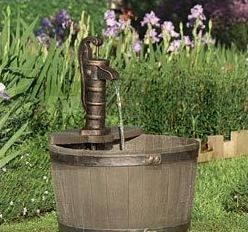





Moving water plays an important role in many container water features. Indeed, the reason for having such a small feature is often that it offers an opportunity to have safe, moving water in the garden or on the patio.
 All you need to produce moving water are a suitable pump and a simple understanding of both flow rates and filtration. You can greatly enhance the clarity of the water by using a filter attached to the pump; in many instances a simple filter unit will already be built into the pump.
All you need to produce moving water are a suitable pump and a simple understanding of both flow rates and filtration. You can greatly enhance the clarity of the water by using a filter attached to the pump; in many instances a simple filter unit will already be built into the pump.
Almost all small water features can be served by a submersible pump. These come in a wide range of shapes and sizes and usually sit in the container underneath the water and recirculate it as a fountain or waterfall. Some pumps require the installation of a separate, buried cable. But there are many low-voltage pumps, and the cable for these can be run on the surface and disguised by plants. It must, however, be protected by plastic conduit where people are going to walk over it. For most small water features, low-voltage pumps are perfectly adequate. Only if significant amounts of water are to be moved will you need a more powerful unit. The provision of the power-supply cable and the method of hiding it are the biggest challenges anyone creating a moving water feature has to contend with.
If you would like to construct a straightforward fountain in a sizeable, uncluttered container, there is another option. It is possible to purchase small solar-powered fountains that work without electricity. These consist of a small, round unit with a built-in pump and a solar panel that is placed on the surface of the water. The height of the fountain jet varies according to the weather, but on a warm, sunny day a jet 30-50 cm (12-20 in) high can be expected.
Whatever configuration of moving water you decide on, it is important to get the flow rate of the water right. When choosing a pump, always select one that will deliver slightly more water over a given time than is required. Having spare capacity allows you to change the type of fountain if you wish to, and since the pump does not need to work at full capacity all the time there is no strain on it and its life is extended.
Volume requirements and movements for most small contained features are modest, and calculations based on standard practice may need to be adapted and scaled down. Broadly speaking, in order to assess a pump’s capacity for a flowing feature, pour water over a cascade unit or something similar from a garden hose at the rate desired. Collect the water delivered over the period of one minute. Measure the quantity that is collected in litres (quarts), multiply by 60, and you have the number of litres (quarts) per hour that the pump must be able to move to produce the desired result. Potential fountain heights are generally described on the packaging of a pump.
The type of fountain spray created depends on which jet you choose. Jets are detachable and merely push or screw on to the pump outlet. There are many different patterns of spray, and also attachments that will ensure a constantly changing sequence — in the most sophisticated cases this can be synchronised with lights and music.
Copyright © www.100flowers.win Botanic Garden All Rights Reserved